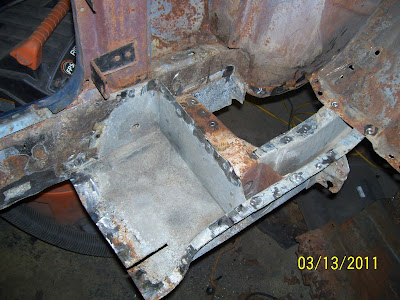I have come to realize one thing after this weekend: God must love Boss 302s! How do I know this? Because he was kind enough to hold off raining all over my nearly-nekid car until Dad and I managed to get her safely inside the shop, and all our blasting sand recovered and put away. Yep…..after two solid days of slinging sand all over creation, I was rewarded with a host of clean metal that was refreshingly solid and surprisingly lacking in the heavy rust damage that was present in so many areas of this car. I am very happy to say that I have reached a point where the major rust damage finally has been removed and getting the new floor welded into the car will have the car about 65-70% structurally complete. Still a lot of complex work to go before “normal” restoration work begins, but pretty significant progress nonetheless.
At this point, the car is ready for me to treat the bare surfaces with phosphoric acid, and start welding in the three major patches required before the floor is installed. This alone will take a few weeks to complete as I still have to fabricate the rear floor transition patch. In the meantime, I will repair the toe boards and clean up some spot weld cutter divots in the front sheet metal flanges. From there, I will coat the inner rockers and firewall area with Zero Rust for protection and move to the rear floor sections needing repair and straightening. Again, lots of work, but great to know that progress is finally starting to show.
For pure entertainment, I also mocked up the Heidt’s four-link forward bracket assembly. This is the major structure added to the car that functions as the forward mounts for the upper and lower trailing arms. While the kit is marketed (and many magazine articles show it) as a “bolt-in” kit, I find this is not likely to be the case. The subtle differences in the 69-70 chassis dictate some slight modifications will be required to make the brackets fit perfectly. In addition, some gaps exist where the bracket saddles the frame rail that are considered “normal”, but that ain’t so around here. Since I plan to weld these structures into my car, I insist that they fit well, while gaps like this may be fine for bolted installations, it won’t be tolerated for a welded installation. So…..more fab work ahead...........as usual. Did I mention I think God loves Boss 302s?
 |
| Here's the car ready for a day of blasting. |
 |
| In the pre-blast inspection, I found two more stress cracks in the chassis. This one is directly beside the axle snubber pad at the rear of the driveshaft tunnel. |
 |
| Passenger side lower torque box and spring mount area looks very nice after blasting. The water-spotted look of the torque box is actually the patina the galvanized metal takes after blasting. |
 |
| Trans cross member and passenger frame rail cleaned up quite nicely too. |
 |
| Driver side inner frame rail and cross member also looks good. Note the galvanized material used in the cross member. |
 |
| Passenger side of the axle tunnel looks surprisingly solid. A little clean-up in this area will work wonders. |
 |
| Here is the driver side axle tunnel. As you can see, I didn't bother blasting the section of the floor transition I plan to remove and replace with new metal. No need to waste the sand...... |
 |
| Driver side inner torque box is excellent! |
 |
| Inner frame rails cleaned up very well. Spot weld cutter divots will be welded up and ground smooth before the floor goes in. |
 |
| The firewall also cleaned up quite well. Still needs a bit of wire wheel work to get everything clean, but that part is comparatively easy. |
 |
| Trans cross member is really very solid. Again, a galvanized part. |
 |
| I couldn't resist mocking up the Heidt's frame mounts. Here's how they tuck into the original leaf spring pockets. |
 |
| Another look at the gap that I will fill before installation. |



















